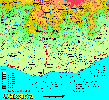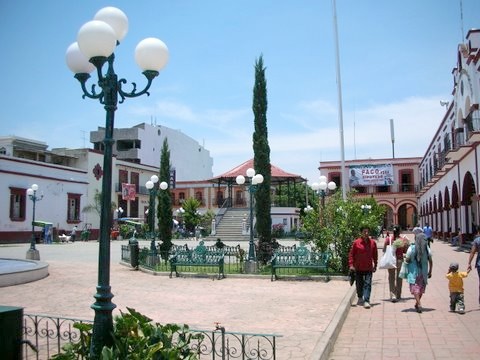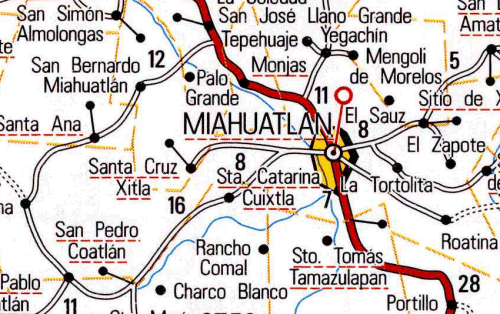Home >>
Oaxaca >>
Mihuatlán
Exploring Oaxaca
An excursion to Mihuatlán, Oaxaca, and Area
GPS: 16°19'N 96°35'W
by Sheila Clarke palomaspto@yahoo.com
May 2007
|

| |
Sheila Clarke, who has been teaching English in her own small language institute in Puerto Escondido since 1993, writes a monthly letter/essay for her family and friends. This year she is on sabbatical with a plan to visit parts of Oaxaca unknown to her. In her May 2007 letter she wrote about her visit to Mihuatlán. - tomzap
|
|
|
|
 My wanderings have taken me near and far this month. The farthest I ranged was to Miahuatlán, about four and a half hours towards the city of Oaxaca. Owing to teachers' meetings, this was the first trip during which I didn't teach. I missed interacting with the kids, but found plenty to do. Miahuatlán itself, an important commercial center of 43,000 residents, was truly unremarkable, but the three small villages I visited, Santa Catarina Cuixtla, San Miguelito and Santa Cruz Xitla, all within forty minutes of the city, were engaging in different ways. My favorite was Xitla (pronounced Sheetlah, which sounds as if it would make an excellent explicative), where the principal crop is flowers. Thousands of blossoms cover fields and hillsides. ¡Qué belleza!
My wanderings have taken me near and far this month. The farthest I ranged was to Miahuatlán, about four and a half hours towards the city of Oaxaca. Owing to teachers' meetings, this was the first trip during which I didn't teach. I missed interacting with the kids, but found plenty to do. Miahuatlán itself, an important commercial center of 43,000 residents, was truly unremarkable, but the three small villages I visited, Santa Catarina Cuixtla, San Miguelito and Santa Cruz Xitla, all within forty minutes of the city, were engaging in different ways. My favorite was Xitla (pronounced Sheetlah, which sounds as if it would make an excellent explicative), where the principal crop is flowers. Thousands of blossoms cover fields and hillsides. ¡Qué belleza!

Miahuatlán More Photos
 The city of Miahuatlán is located in the Sierra Madre del Sur on Hwy 175 64 miles (103 km) south of Oaxaca City at an altitude of 5250' (1600 meters).
The city of Miahuatlán is located in the Sierra Madre del Sur on Hwy 175 64 miles (103 km) south of Oaxaca City at an altitude of 5250' (1600 meters).
|
 Miahuatlán is not a tourist town and I was again a novelty. As I sipped sweet café de la olla from a soup bowl sized cup in a small public market comedor on my first morning there, the owner asked me about my stay. When I mentioned that I was headed to Santa Cruz Xitla, she made a face somewhere between alarm and distaste. She told me that the people there were cerrada (closed), sospechosa (suspicious) and agresiva. I told her I longed to see the flowers. Her response? "Be careful!" Hmm.
Miahuatlán is not a tourist town and I was again a novelty. As I sipped sweet café de la olla from a soup bowl sized cup in a small public market comedor on my first morning there, the owner asked me about my stay. When I mentioned that I was headed to Santa Cruz Xitla, she made a face somewhere between alarm and distaste. She told me that the people there were cerrada (closed), sospechosa (suspicious) and agresiva. I told her I longed to see the flowers. Her response? "Be careful!" Hmm.
 When I arrived in Xitla, I learned that some people were indeed suspicious of outsiders--a suspicion founded in years of conflict with their neighbors in Santa Catarina Cuixtla. Xitla is an indigenously brown Zapotec town. Cuixtla is whiter and Spanish-speaking. There have been land disputes between the two small cities, both of which have fewer than 3000 inhabitants, for centuries; they continue through the present. In the early days of the conflict, Spanish-speaking courts favored white Cuixtla (a prejudice that still prevails); Xitla's Zapotec-speaking leaders could be easily tricked owing to their lack of knowledge of judicial proceedings as well as the language dilemma. The courts consistently awarded land to Cuixtla which Xitla had to fight to regain.
When I arrived in Xitla, I learned that some people were indeed suspicious of outsiders--a suspicion founded in years of conflict with their neighbors in Santa Catarina Cuixtla. Xitla is an indigenously brown Zapotec town. Cuixtla is whiter and Spanish-speaking. There have been land disputes between the two small cities, both of which have fewer than 3000 inhabitants, for centuries; they continue through the present. In the early days of the conflict, Spanish-speaking courts favored white Cuixtla (a prejudice that still prevails); Xitla's Zapotec-speaking leaders could be easily tricked owing to their lack of knowledge of judicial proceedings as well as the language dilemma. The courts consistently awarded land to Cuixtla which Xitla had to fight to regain.
 As I approached the municipal building (always one of my first stops), I heard mournful reverberations of a conch shell--three times, four, five. I discovered that the police are called to the plaza by a councilman blowing the shell! I was glad to learn they werenít being called because I was there, because when I met the presidente municipal, I decided that the woman at the market may have been correct in her assessment of the people of Xitla. The polŪtico examined my card very carefully, turning it this way and that, and was not welcoming in any way, perhaps because the "Lic." (for licenciada) before my name could identify me as a lawyer. After about ten minutes, however, I seemed to win him over with humor. With that notable exception, the people were lovely to me. Josefina, a flower grower I encountered on my way to the cemetery, and her three daughters took me under their wings. They showed me all the varieties of flowers and the complex irrigation process. They gave me a huge bouquet, fed me bread and coffee, and told me about their lives. They also rescued me from a potentially embarrassing cultural faux pas.
As I approached the municipal building (always one of my first stops), I heard mournful reverberations of a conch shell--three times, four, five. I discovered that the police are called to the plaza by a councilman blowing the shell! I was glad to learn they werenít being called because I was there, because when I met the presidente municipal, I decided that the woman at the market may have been correct in her assessment of the people of Xitla. The polŪtico examined my card very carefully, turning it this way and that, and was not welcoming in any way, perhaps because the "Lic." (for licenciada) before my name could identify me as a lawyer. After about ten minutes, however, I seemed to win him over with humor. With that notable exception, the people were lovely to me. Josefina, a flower grower I encountered on my way to the cemetery, and her three daughters took me under their wings. They showed me all the varieties of flowers and the complex irrigation process. They gave me a huge bouquet, fed me bread and coffee, and told me about their lives. They also rescued me from a potentially embarrassing cultural faux pas.
 When I was wandering through the cemetery, I noticed several baskets discarded here and there. I was drawn to their color and form, but the ones I picked up to examine were rather dirty and falling apart. Leaving the cemetery from the opposite side from which I'd entered, I found another basket, this one intact. As I had passed among the graves, Iíd stopped to chat about their art form with some tomb builders, who were almost comically taken aback to discover a white female foreigner in the graveyard. I asked them if I might take the basket with me as it was so clearly abandoned. "¡Cómo no!" Certainly! So off I went with my find to reunite with Josefina and her daughters who were waiting for me on a hillside far above.
When I was wandering through the cemetery, I noticed several baskets discarded here and there. I was drawn to their color and form, but the ones I picked up to examine were rather dirty and falling apart. Leaving the cemetery from the opposite side from which I'd entered, I found another basket, this one intact. As I had passed among the graves, Iíd stopped to chat about their art form with some tomb builders, who were almost comically taken aback to discover a white female foreigner in the graveyard. I asked them if I might take the basket with me as it was so clearly abandoned. "¡Cómo no!" Certainly! So off I went with my find to reunite with Josefina and her daughters who were waiting for me on a hillside far above.
 As we approached each other on the steep winding path, I detected worry on Josefina's face as she stared at the basket. She asked where Iíd gotten it, though she must have known. "Throw it down quickly," she said. Of course I did. "Why?" I wanted to know, explaining that the men had given me permission to take it. For nine days after a personís death, flowers, candles and a sand painting made with colored sand and glitter mark the spot where a person dies. The rosary and other prayers are sung and chanted without stop begging God that the deceased's sprit will find everlasting peace. On the ninth day the sand painting is destroyed and is gathered up along with flower petals and candles, put in a basket, called a tenate, and carried to the graveyard where its contents are emptied on top of the grave, symbolically joining the spirit with the body. Had I been seen carrying a used tenate, itís possible that some would have considered me to be profaning a departed soulís spirit.
As we approached each other on the steep winding path, I detected worry on Josefina's face as she stared at the basket. She asked where Iíd gotten it, though she must have known. "Throw it down quickly," she said. Of course I did. "Why?" I wanted to know, explaining that the men had given me permission to take it. For nine days after a personís death, flowers, candles and a sand painting made with colored sand and glitter mark the spot where a person dies. The rosary and other prayers are sung and chanted without stop begging God that the deceased's sprit will find everlasting peace. On the ninth day the sand painting is destroyed and is gathered up along with flower petals and candles, put in a basket, called a tenate, and carried to the graveyard where its contents are emptied on top of the grave, symbolically joining the spirit with the body. Had I been seen carrying a used tenate, itís possible that some would have considered me to be profaning a departed soulís spirit.
 I know the rains will make the beautiful, remote places I've visited even more spectacular, but I had to begin in the dry season. On my next to the last trip of the month, I explored three villages high in the mountains where the rains have already begun in earnest. The opulent, exuberant forests were welcome relief after having seen forests denuded by corrupt lumbering practices in other parts of the state. The breathtaking ecosystem included countless butterflies, including one trailing its gossamer chrysalis, looking for all the world like a delicate parachute, by an invisible thread. I doubt thereíll be time to return to any of my favorite villages this year, but perhaps I might sometime in the future. There was a time not long ago when I wondered if Iíd meet my goal of sixty villages, but now, halfway there, I know I will. Oaxacan friends and acquaintances tell me of places I mustnít miss. Yesterday, a lawyer for the Mexican equivalent of the IRS came to the house to confirm that Iím not teaching and spent two hours showing me villages on her map. Her work has taken her to many corners of the state, and she left me with a list of ideas for the next monthsí visits. Though I've observed some fabric weaving and basket making, I'm looking forward to seeing more places where crafts are as important as crops. I know Iíll find those sites closer to the city of Oaxaca.
I know the rains will make the beautiful, remote places I've visited even more spectacular, but I had to begin in the dry season. On my next to the last trip of the month, I explored three villages high in the mountains where the rains have already begun in earnest. The opulent, exuberant forests were welcome relief after having seen forests denuded by corrupt lumbering practices in other parts of the state. The breathtaking ecosystem included countless butterflies, including one trailing its gossamer chrysalis, looking for all the world like a delicate parachute, by an invisible thread. I doubt thereíll be time to return to any of my favorite villages this year, but perhaps I might sometime in the future. There was a time not long ago when I wondered if Iíd meet my goal of sixty villages, but now, halfway there, I know I will. Oaxacan friends and acquaintances tell me of places I mustnít miss. Yesterday, a lawyer for the Mexican equivalent of the IRS came to the house to confirm that Iím not teaching and spent two hours showing me villages on her map. Her work has taken her to many corners of the state, and she left me with a list of ideas for the next monthsí visits. Though I've observed some fabric weaving and basket making, I'm looking forward to seeing more places where crafts are as important as crops. I know Iíll find those sites closer to the city of Oaxaca.
This page has been visited times since July 22, 2007.
| Top of page |
Main index |
Search |
What's new |
The Pacific Coast of Mexico
 www.tomzap.com
www.tomzap.com
 Tom Penick:
tom@tomzap.com
Tom Penick:
tom@tomzap.com
![]() My wanderings have taken me near and far this month. The farthest I ranged was to Miahuatlán, about four and a half hours towards the city of Oaxaca. Owing to teachers' meetings, this was the first trip during which I didn't teach. I missed interacting with the kids, but found plenty to do. Miahuatlán itself, an important commercial center of 43,000 residents, was truly unremarkable, but the three small villages I visited, Santa Catarina Cuixtla, San Miguelito and Santa Cruz Xitla, all within forty minutes of the city, were engaging in different ways. My favorite was Xitla (pronounced Sheetlah, which sounds as if it would make an excellent explicative), where the principal crop is flowers. Thousands of blossoms cover fields and hillsides. ¡Qué belleza!
My wanderings have taken me near and far this month. The farthest I ranged was to Miahuatlán, about four and a half hours towards the city of Oaxaca. Owing to teachers' meetings, this was the first trip during which I didn't teach. I missed interacting with the kids, but found plenty to do. Miahuatlán itself, an important commercial center of 43,000 residents, was truly unremarkable, but the three small villages I visited, Santa Catarina Cuixtla, San Miguelito and Santa Cruz Xitla, all within forty minutes of the city, were engaging in different ways. My favorite was Xitla (pronounced Sheetlah, which sounds as if it would make an excellent explicative), where the principal crop is flowers. Thousands of blossoms cover fields and hillsides. ¡Qué belleza!
![]() www.tomzap.com
www.tomzap.com
![]() Tom Penick:
tom@tomzap.com
Tom Penick:
tom@tomzap.com